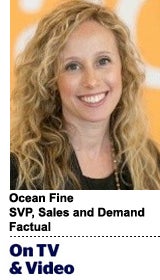“On TV and Video” is a column exploring opportunities and challenges in advanced TV and video.
Today’s column is written by Ocean Fine, senior vice president of sales and demand at Factual.
Linear TV has always attracted ad budget from the Johnson & Johnsons and Campbell Soups of the world. In the digital era, those players are increasingly investing in OTT, as do newer ones like Blue Apron and HelloFresh.
OTT is a different kind of experience from linear TV because the former lets viewers watch their favorite content on demand rather than live, representing an opportunity for brands to connect with consumers in a channel where they are in control. Not to mention that OTT audience buying can be more targeted with advanced viewer data, such as demographics, relevant segments and consumer interest categories, compared to traditional TV.
Measurement, however, has been a challenge for OTT advertisers, particularly for grocery players like CPGs and supermarket chains that want to get a clearer understanding of what ads drive foot traffic and boost sales.
But connecting advertising to in-store sales is moving from a decades-old dream to an actual reality in the digital age. Location is one way to connect the dots. With location, marketers can connect OTT ad exposure to in-store visitation and incremental sales. For instance, video ads company FreeWheel has used location data to measure sales impact of up to 9.9% for retailers.
OTT ads can also be measured for in-store impact by Nielsen Catalina, which offers cross-device data sets that measure sales effectiveness by looking at audiences that are exposed to the ad campaign versus unexposed audiences. Measurement player IRI also is designed to target and measure OTT ads with purchase insights for specific brands with the aim of growing loyalty.
About one-eighth of TV inventory is now available for addressable advertising, including 65 million-plus US households to target. The scale is there, but the inventory is not. As OTT ad measurement continues to improve, this inventory problem will likely be solved sooner rather than later due to the opportunity for brands to reach these households.
Early adopters
Some legacy brands just seem to understand the shifting landscape of media consumption better than others.
For instance, Kroger is lifting its spend on OTT ads after seeing 82% incremental reach on Hulu for 25- to-54-year-old consumers. The 136-year-old grocery brand also discovered that 95% of its target demographic turned out to be folks who watch little to no linear TV, underscoring how crucial OTT has become to its advertising mix.
And Johnson & Johnson, which accounts for nearly 4% of the global beauty market, has increased its YouTube advertising budget by 250% in the last four years.
For its Neutrogena beauty line, J&J recently ran 21 different videos and used data to target viewers based on the time of day and the local weather. The initiative produced a 14% sales jump, and 72% of those sales were from new customers. Taking a page out of the direct-to-consumer playbook, the company worked with social influencers Olivia and Cade in one video ad that received 15.5 million views. A J&J exec characterized the results as an “unprecedented return on investment.”
J&J shows an opportunity for CPG brands to develop a more robust direct-to-consumer strategy. Away, Dollar Shave Club, Rent the Runway and other DTCs have upended legacy CPG markets by bypassing the middle layer. Now with OTT and its new measurement capabilities and built-in phone/smart TV/tablet functionality, big brands like J&J can actually build a direct relationship – and not just brand affinity.
The need to future-proof
Though the lion’s share of TV-minded advertising is still on linear TV, it’s clear the marketplace is moving more toward OTT. And CPGs and grocery players are starting to realize the potential for measuring campaign performance in OTT.
On a larger scale, it’s all about becoming digital-first companies as media consumption continues to shift online. On a more granular level, it’s all about whether a campaign drove people into a store and then evolving the creative and media strategy around the incoming data.
Change is never easy. But the good news in the OTT era is that performance data exists like never before for CPGs and grocers, helping ad buyers to convince their higher-ups to change with the times.
Follow Factual (@factual) and AdExchanger (@adexchanger) on Twitter.














